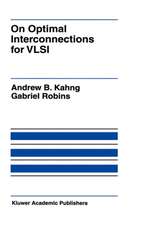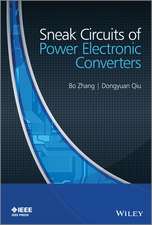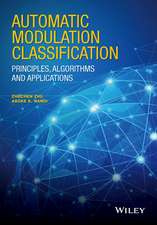VLSI Physical Design: From Graph Partitioning to Timing Closure
Autor Andrew B. Kahng, Jens Lienig, Igor L. Markov, Jin Huen Limba Engleză Hardback – 16 iun 2022
“This improved, second edition of the book will continue to serve the EDA and design community well. It is a foundational text and reference for the next generation of professionals who will be called on to continue the advancement of our chip design tools and design the most advanced micro-electronics.”
Dr. Leon Stok, Vice President, Electronic Design Automation, IBM Systems Group
“This is the book I wish I had when I taught EDA in the past, and the one I’m using from now on.”
Dr. Louis K. Scheffer, Howard Hughes Medical Institute
“I would happily use this book when teaching Physical Design. I know of no other work that’s as comprehensive and up-to-date, with algorithmic focus and clear pseudocode for the key algorithms. The book is beautifully designed!”
Prof. John P. Hayes, University of Michigan
“The entire field of electronic design automation owes the authors a great debt for providing a single coherent source on physical design that is clear and tutorial in nature, while providing details on key state-of-the-art topics such as timing closure.”
Prof. Kurt Keutzer, University of California, Berkeley
“An excellent balance of the basics and more advanced concepts, presented by top experts in the field.”
Prof. Sachin Sapatnekar, University of Minnesota
| Toate formatele și edițiile | Preț | Express |
|---|---|---|
| Paperback (2) | 354.63 lei 3-5 săpt. | +22.60 lei 4-10 zile |
| Springer International Publishing – 17 iun 2023 | 354.63 lei 3-5 săpt. | +22.60 lei 4-10 zile |
| SPRINGER NETHERLANDS – 15 oct 2014 | 528.80 lei 6-8 săpt. | |
| Hardback (1) | 592.12 lei 6-8 săpt. | |
| Springer International Publishing – 16 iun 2022 | 592.12 lei 6-8 săpt. |
Preț: 592.12 lei
Preț vechi: 696.60 lei
-15% Nou
Puncte Express: 888
Preț estimativ în valută:
113.34€ • 123.15$ • 95.27£
113.34€ • 123.15$ • 95.27£
Carte tipărită la comandă
Livrare economică 21 aprilie-05 mai
Preluare comenzi: 021 569.72.76
Specificații
ISBN-13: 9783030964146
ISBN-10: 3030964140
Pagini: 317
Ilustrații: XVII, 317 p. 335 illus. in color.
Dimensiuni: 155 x 235 x 26 mm
Greutate: 0.64 kg
Ediția:2nd ed. 2022
Editura: Springer International Publishing
Colecția Springer
Locul publicării:Cham, Switzerland
ISBN-10: 3030964140
Pagini: 317
Ilustrații: XVII, 317 p. 335 illus. in color.
Dimensiuni: 155 x 235 x 26 mm
Greutate: 0.64 kg
Ediția:2nd ed. 2022
Editura: Springer International Publishing
Colecția Springer
Locul publicării:Cham, Switzerland
Cuprins
1 Introduction.- 2 Netlist and System Partitioning.- 3 Chip Planning.- 4 Global and Detailed Placement.- 5 Global Routing.- 6 Detailed Routing.- 7 Specialized Routing.- 8 Timing Closure. A Solutions to Chapter Exercises.- B Example CMOS Cell Layouts.
Notă biografică
Andrew B. Kahng is Professor of CSE and ECE at UC San Diego, where he holds the endowed chair in High-Performance Computing. He has served as visiting scientist at Cadence (1995-1997) and as founder, chairman and CTO at Blaze DFM (2004-2006).
Jens Lienig is Professor of Electrical Engineering at TU Dresden. He is also the director of the Institute of Electromechanical and Electronic Design at TUD. He has worked as project manager at Tanner Research, Inc. (1996-1999) and Robert Bosch GmbH (1999-2002).
Igor L. Markov is a Fellow of IEEE and an ACM Distinguished Scientist. In addition to his career as a Professor of Electrical Engineering and Computer Science at the University of Michigan, he has worked at Google (2014-2017) and has been with Facebook since 2018.
Jin Hu was a PhD student at the Computer Science and Engineering (CSE) Division at the University of Michigan. Afterwards, she has been with IBM Corp. (2013-2017), Bloomberg L.P. (2017-2019) and Two Sigma Insurance Quantified (TSIQ) (since 2019).
Jens Lienig is Professor of Electrical Engineering at TU Dresden. He is also the director of the Institute of Electromechanical and Electronic Design at TUD. He has worked as project manager at Tanner Research, Inc. (1996-1999) and Robert Bosch GmbH (1999-2002).
Igor L. Markov is a Fellow of IEEE and an ACM Distinguished Scientist. In addition to his career as a Professor of Electrical Engineering and Computer Science at the University of Michigan, he has worked at Google (2014-2017) and has been with Facebook since 2018.
Jin Hu was a PhD student at the Computer Science and Engineering (CSE) Division at the University of Michigan. Afterwards, she has been with IBM Corp. (2013-2017), Bloomberg L.P. (2017-2019) and Two Sigma Insurance Quantified (TSIQ) (since 2019).
Textul de pe ultima copertă
The complexity of modern chip design requires extensive use of specialized software throughout the process. To achieve the best results, a user of this software needs a high-level understanding of the underlying mathematical models and algorithms. In addition, a developer of such software must have a keen understanding of relevant computer science aspects, including algorithmic performance bottlenecks and how various algorithms operate and interact. This book introduces and compares the fundamental algorithms that are used during the IC physical design phase, wherein a geometric chip layout is produced starting from an abstract circuit design. This updated second edition includes recent advancements in the state-of-the-art of physical design, and builds upon foundational coverage of essential and fundamental techniques. Numerous examples and tasks with solutions increase the clarity of presentation and facilitate deeper understanding. A comprehensive set of slides is available on the Internet for each chapter, simplifying use of the book in instructional settings.
Link with additional documents: https://www.ifte.de/books/eda/index.html
“This improved, second edition of the book will continue to serve the EDA and design community well. It is a foundational text and reference for the next generation of professionals who will be called on to continue the advancement of our chip design tools and design the most advanced micro-electronics.”
Dr. Leon Stok, Vice President, Electronic Design Automation, IBM Systems Group
“This is the book I wish I had when I taught EDA in the past, and the one I’m using from now on.”
Dr. Louis K. Scheffer, Howard Hughes Medical Institute
“I would happily use this book when teaching Physical Design. I know of no other work that’s as comprehensive and up-to-date, with algorithmic focus and clear pseudocode for the key algorithms. The book is beautifully designed!”
Prof. John P. Hayes, University of Michigan
“The entire field of electronic design automation owes the authors a great debt for providing a single coherent source on physical design that is clear and tutorial in nature, while providing details on key state-of-the-art topics such as timing closure.”
Prof. Kurt Keutzer, University of California, Berkeley
“An excellent balance of the basics and more advanced concepts, presented by top experts in the field.”
Prof. Sachin Sapatnekar, University of Minnesota
Link with additional documents: https://www.ifte.de/books/eda/index.html
“This improved, second edition of the book will continue to serve the EDA and design community well. It is a foundational text and reference for the next generation of professionals who will be called on to continue the advancement of our chip design tools and design the most advanced micro-electronics.”
Dr. Leon Stok, Vice President, Electronic Design Automation, IBM Systems Group
“This is the book I wish I had when I taught EDA in the past, and the one I’m using from now on.”
Dr. Louis K. Scheffer, Howard Hughes Medical Institute
“I would happily use this book when teaching Physical Design. I know of no other work that’s as comprehensive and up-to-date, with algorithmic focus and clear pseudocode for the key algorithms. The book is beautifully designed!”
Prof. John P. Hayes, University of Michigan
“The entire field of electronic design automation owes the authors a great debt for providing a single coherent source on physical design that is clear and tutorial in nature, while providing details on key state-of-the-art topics such as timing closure.”
Prof. Kurt Keutzer, University of California, Berkeley
“An excellent balance of the basics and more advanced concepts, presented by top experts in the field.”
Prof. Sachin Sapatnekar, University of Minnesota
Caracteristici
Comprehensive textbook coverage of physical design of integrated circuits, PCBs and MCMs A chapter on timing closure that includes a discussion of design flows Detailed illustrations of key concepts, numerous examples, and tasks with solutions






















